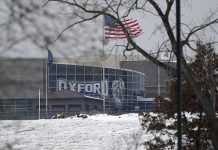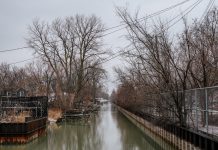
The Church of the Messiah has long held a build-a computer program where anyone can refurbish an out-dated computer, then take it home.
A couple of Christmas seasons ago, on the night before kids went back to school, Wallace Gilbert, the assistant pastor of the nontraditional Episcopalian church, remembers all of the computers in the lab were being used.
Puzzled, he asked the kids, “What’s going on here?” They have homework to finish, they said. “I said [to one of the young men,] ‘I personally helped you build a machine.’ He said, ‘I don’t have the internet [at home].’ I’m like, wow, we’re building all these computers, they’re taking them home, but they don’t have the internet so basically, I’m just giving them typewriters.”
That was a catalyst for Gilbert to get the church involved in the Equitable Internet Initiative, a part of the Detroit Community Technology Project. The DCTP grew out of the nonprofit Allied Media Projects’ digital media education and community technology work in Detroit.
In the city, 40 percent of residents don’t have access to the internet. Compare that to a city like Chicago, where 25 percent lack access, or Baltimore, where 30 percent can’t get online.
Lack of access is directly correlated to the poverty level, which is also 40 percent in Detroit, according to the census, says Monique Tate, a digital steward trainer with the initiative at WNUC, a community radio station based in the North End.
WNUC is among three anchor organizations collaborating on the internet project that aims to increase access through the distribution of shared gigabit connections in three Detroit neighborhoods: Islandview, North End, and Southwest.
“The program is more than just technology. The main focus … is community organizing.”
—Wallace Gilbert
In today’s increasingly digital world — you can hardly pay for a utility bill or apply for a job without a computer — the internet is becoming more difficult to live without. And for the 2020 census, most Americans will be recording their responses online. So what does that mean for a city where 40 percent of its residents don’t have the internet?
Equitable Internet Initiative’s goal is to connect about 150 residents in Southwest, Islandview, and North End by July, giving them access to low-cost, high-speed internet. The infrastructure is being built by digital stewards, who are part technicians, part community organizers. It’s an internet being built for the community, by the community.
“Building their own infrastructure is what we feel is the key to sustainability,” says Diana Nucera, director of the DCTP. “People of color, women, and the trans and queer community are often left out [of tech because] it’s a very male, white-dominated field. As a woman of color, it’s my mission to change that and diversify the field, because I don’t think we can have an equitable future in technology without a diverse group of people at the table.”
Their project has funding for one year. And after that, it’s up to each community to come up with a business plan to sustain it.
Nucera emphasizes that the digital stewards are not your “usual group of technologists.” They’re community organizers, artists, people who truly understand how technology and media intersect. “That’s what makes them experts. This work is really trying to shift the narrative of who a technologist is and what they do.”
Empowering Youth in Islandview
When Dwight Roston was 16, his grades were poor, he was getting into fights, and ended up on probation. “I was doing a lot of stupid stuff,” says the now 23-year-old.

That’s when he found the Church of the Messiah on the east side of Detroit. It was the only place he could go where he could spend a whole day in the computer lab where he taught himself music and video production. One time, he asked if he could use a microphone to work on his music. Sure, he was told, but there was a catch — it was broken so if he could fix it, he could use it.
It took him several hours of taking it apart and putting it back together, but he eventually figured it out. He realized he had a knack for working with his hands as well as with technology.
Today, Roston has his own production company and is one of the digital stewards in the Islandview community where he has lived for five years.
Empowering people like Roston is at the core of the Church of the Messiah’s mission, says assistant pastor Gilbert, who project manages the Equitable Internet Initiative for the church and the Boulevard Harambee Empowerment Center, the church’s ministry. The church also owns more than 200 units of affordable housing.
“The difference between what the Equitable Internet Initiative is doing and just a person having the internet, is we’ve built the intranet,” Gilbert says. “For instance, say our internet connection was gone, we still have our wireless network in place. You can still communicate with your neighbors.”
Having an intranet will help make sure residents are getting “true and relevant information in a speedy fashion,” especially as Islandview undergoes rapid change with new investments being poured into the neighborhood and the gentrification that can come with those new investments.
While information is power, Gilbert sees another facet to the initiative: a brighter future for the stewards putting in the equipment for residents.
“These guys can go out and work for any tech company,” he says. “It’s changed their mindset: they’re going back to school, getting driver’s licenses, trying to get GEDs. The program is more than just technology. The main focus of the program is community organizing.”
Roston had long considered himself a youth ambassador because of his affiliation with the church, but being a digital steward has added another dimension to community organizing for him as he’s getting to know more people in the neighborhood, young and old.
“When we’re out installing the internet, people look at it like it can actually be done on a community level. It can … be a tool in the community’s hands.”
Providing Power in the North End

Like Roston, Monique Tate didn’t have much of a background in tech, at least not on the hardware side. She had experience in the corporate world, as a marketer and commercial insurance professional.
She was working as a diversity marketing consultant at Chrysler Financial when the Great Recession hit. Before she left, she had become somewhat of a subject matter expert when her office converted to computer-based systems.
“That was my first introduction on the software side of things,” she says. “But on the hardware side or building networks … I knew nothing about that.”
She found out about plans to build a wireless network in her Morningside neighborhood and then became trained as a digital steward there in 2013. “I was so intrigued by the idea that we could provide internet for the community that I was willing to learn whatever they were willing to offer.”
Today, as the digital steward trainer in the North End, Tate trains digital stewards in this neighborhood north of New Center. Like Islandview, it’s also undergoing major gentrification with its proximity to Midtown.
When putting the steward team together, she wanted to ensure she had a diverse group. About 18 were invited to take the training, which ran for several weeks; 11 graduated and five were hired as the digital steward apprentices to build the network. Two of them had no technical knowledge, but they were community organizers, and that’s why she picked them. The others had more of a tech background, but came from music production and beat making.
No matter what their experience level was when they started, they can all do a complete installation in no time flat, she says.
The network will be key in the neighborhood’s disaster preparedness plan. She highlights its importance by recalling three disasters that occurred during the course of the stewards’ training.
“Within that four-month time, we had three emergencies: one was water, there was a boil water alert, then we had flooding, and then we had a power outage.”
Tate says they’re looking at creating plans for sustainability and how to fund the project beyond the initial funding phase. Funding for sustainability is one of the key threats to the program, she says, in addition to lack of equipment and literacy.
“I think that the value proposition here is that we are able to provide internet to those who otherwise would not have it,” she says, adding “education is essential because education is about understanding the value and importance of being connected. … Education is powerful, if you have it, no one can take it away from you.
“But ownership makes you incredible and phenomenal because you now are in charge of your destiny. Because you have a community-owned and community-governed internet not impacted by net neutrality. I think that is a gem in providing that kind of power.”
Building from the Inside in Southwest Detroit
A few years ago, there were a group of entrepreneurial youth who were interested in technology, and so Radical Productions, a youth-run collective that provides website and app design services for residents in Southwest Detroit, was born.
The program entails a six-month to one-year training program in graphic design and computer coding. Reliable and fast internet service is a must for these young tech entrepreneurs to prosper.
When they first started, they were unable to access anything that was above five megabits of internet. “It was extremely slow,” says Meghan Sobocienski, director of collectives at Grace in Action, which is Southwest’s anchor organization for the Equitable Internet Initiative. It’s also a home base for Radical Productions as well as other worker-owned creative cooperatives. They struggled to have any sort of speed that was conducive to what they were trying to do. “It was not only youth running a business, but youths of color running a business and then trying to compete with internet that is 10 times slower than what most businesses have. So, I think that is the early sort of reason that we were really drawn to [the] Equitable Internet Initiative project.”
“This work is really trying to shift the narrative of who a technologist is and what they do.”
—Diana Nucera
Another issue is whenever there’s a wind storm, the networks will go down and they go down often. Sometimes they don’t come back up for days.
But when digital stewards are living among neighbors, it can come back up much faster. “So, the ability to repair what has come down is much faster and much higher and eventually, with neighbors learning themselves how to do that work, we’re not reliant on outside corporations but rather able to repair these things ourselves. I think [that] is really important,” Sobocienski says.
Nyasia Valdez is the digital steward trainer in Southwest where she was born and raised. The 22-year-old had no background in tech other than learning how to take apart an iPhone by watching videos online. But she’s been community organizing since she was 15, when she made a phone call to Congress in support of the DREAM Act. She worked with an immigration rights group to help prevent the deportation of a Roseville man brought illegally to the U.S. from Russia. She then realized the power she had as an organizer and has been advocating for immigration rights ever since.
Her team of young adults in the neighborhood, range in ages from 18-27, and like her, they didn’t have tech backgrounds. But they were all organizers — two of them artists. As of press time, they had connected four houses and plan to not only connect up to 50 more but also create hubs for residents to gain access to the internet.
“Right now, a lot of people are getting displaced in the neighborhood for different reasons,” Valdez says, adding that another challenge in the neighborhood is a language barrier. “The narrative about the city is that it’s new, it’s shiny, and that all these corporations should come. Amazon should come, Google should come. But who are they serving if 40 percent of Detroit is without internet?” Through the internet initiative, Valdez says residents can have the power to improve their situation through education.
Sobocienski says the initiative is also about placemaking. “It’s working within a place and within a space and building capacity. Rather than bringing capacity from the outside, it’s building capacity from the inside.”
|
|
|









